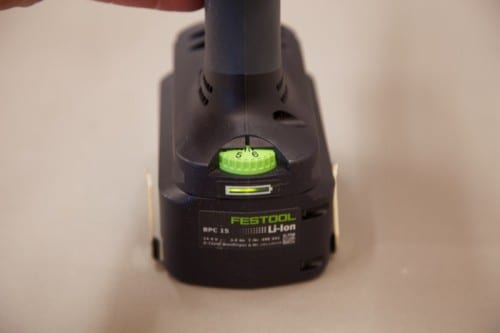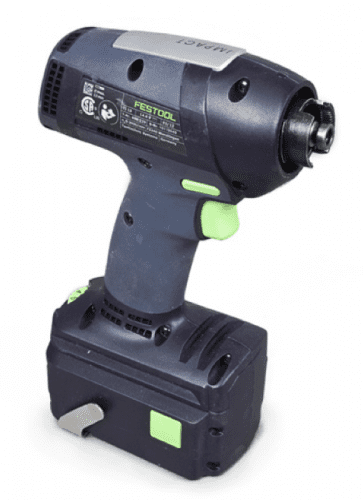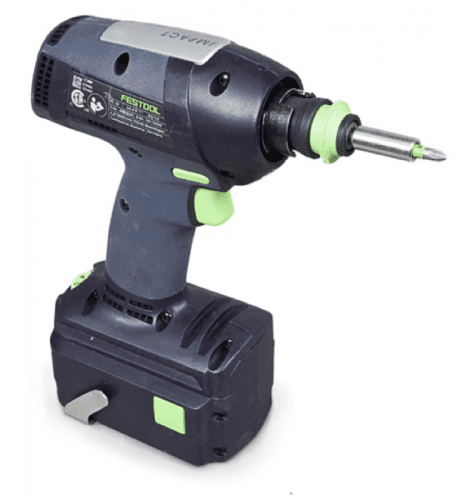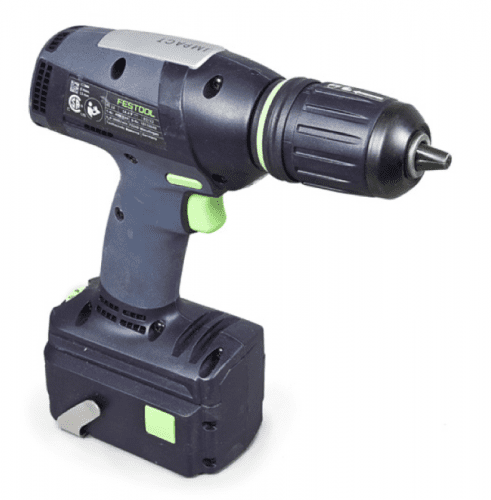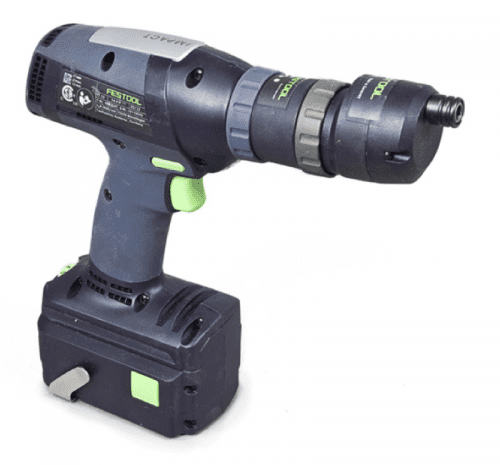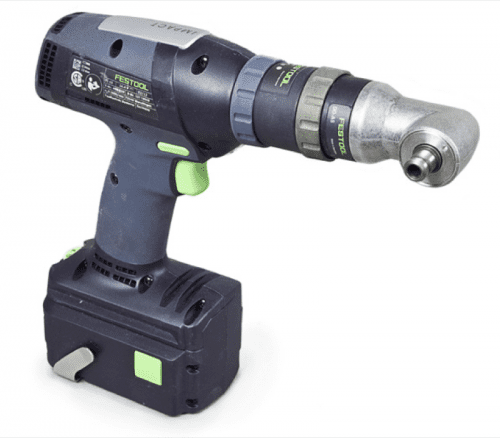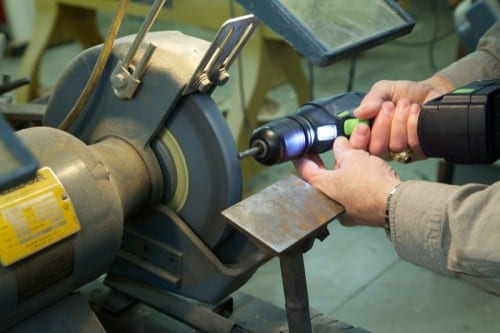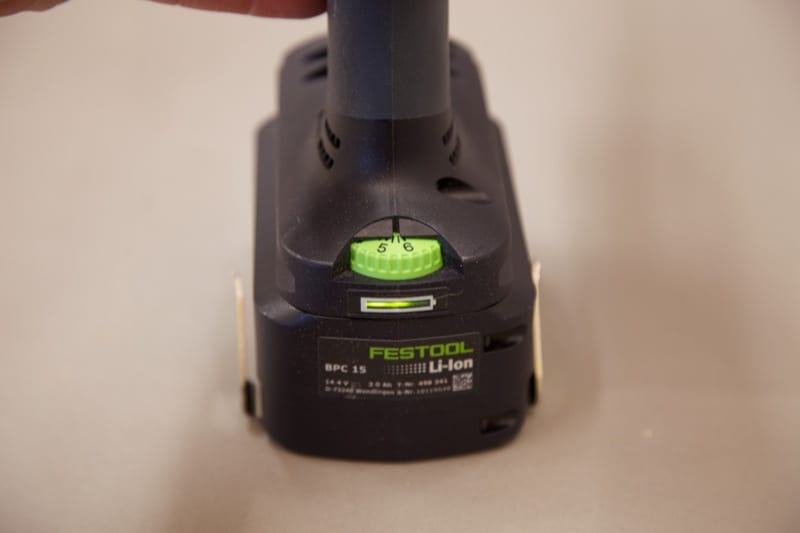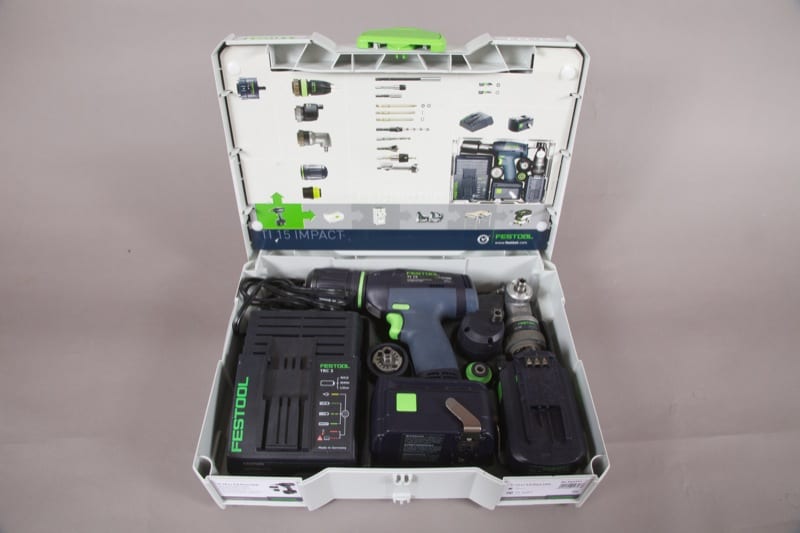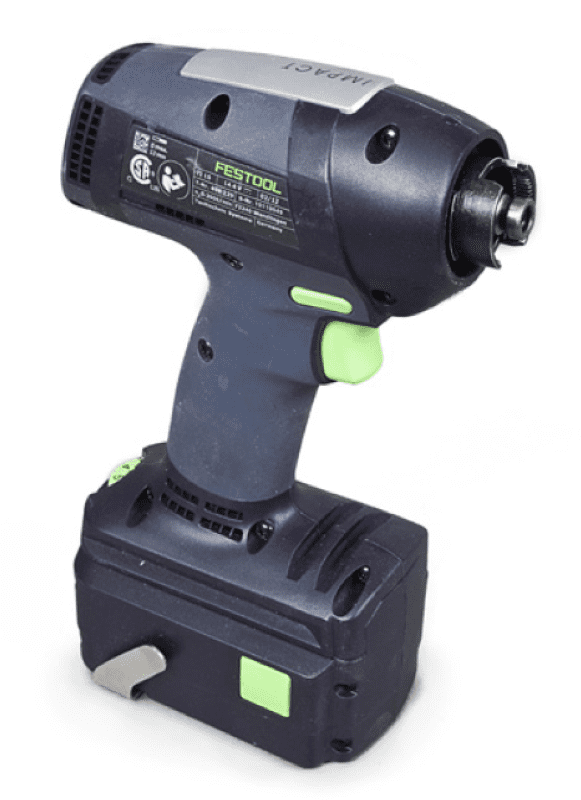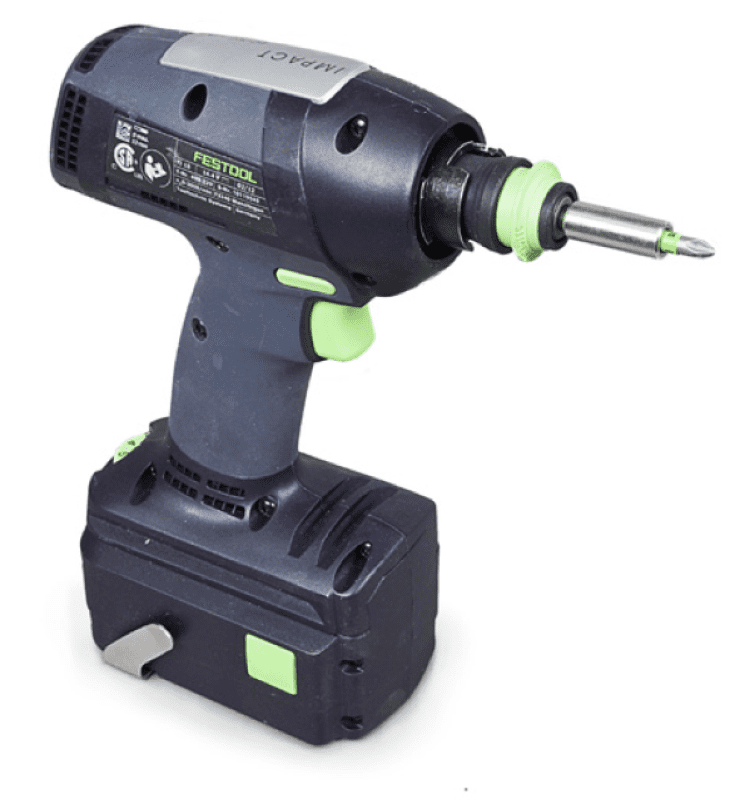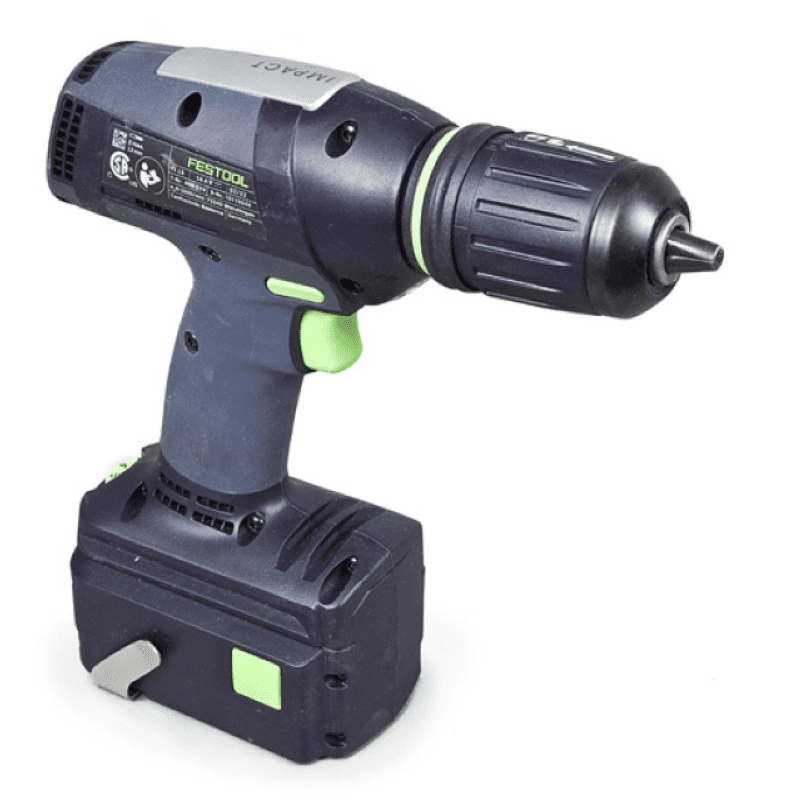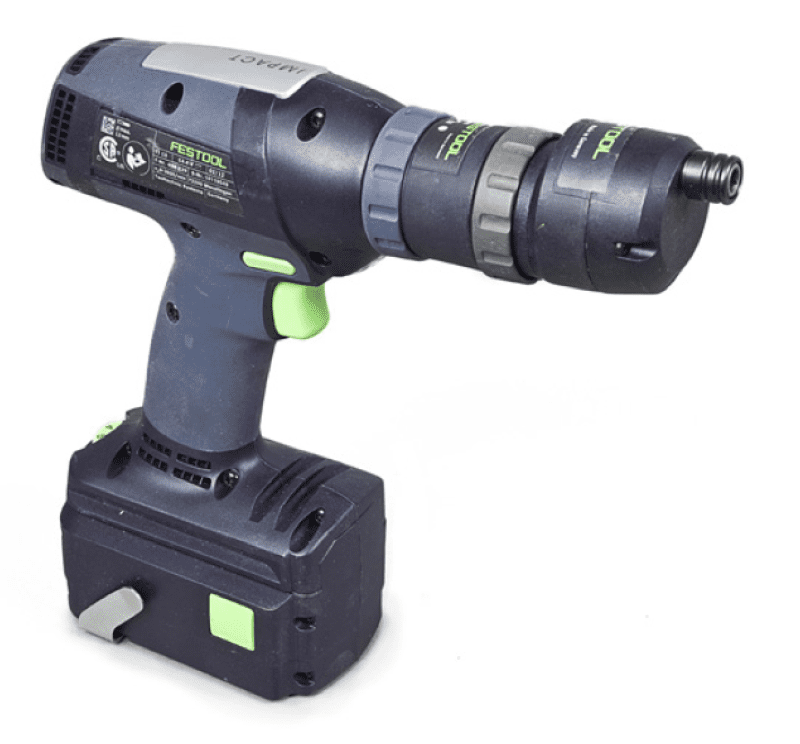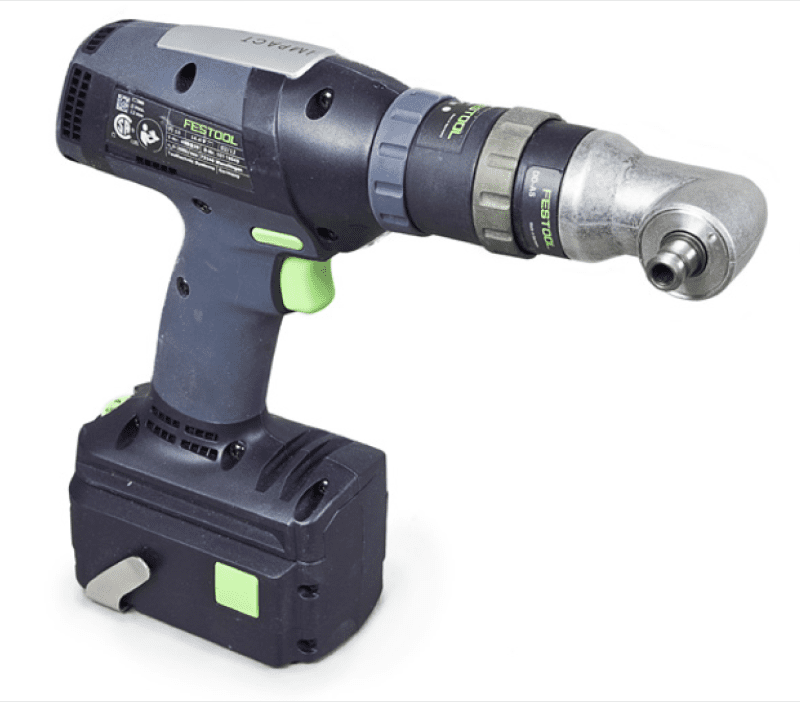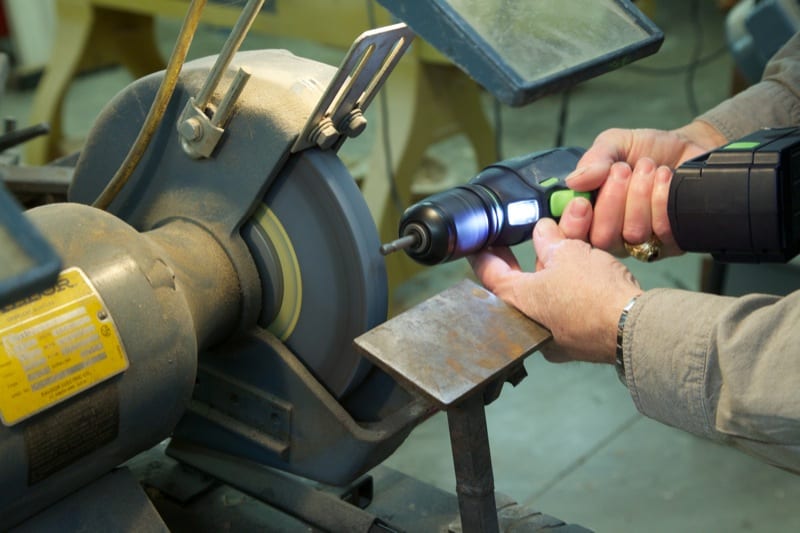The Festool TI 15 +3 Impact/Drill Driver is the latest addition to this premier German manufacturer’s extensive line of portable power tools. A Freudian slip could be expensive line of tools, for in the German language all Festools are furchtbar teuer or frightfully expensive. On exiting the store you can rest assured you have paid about as much as you can pay for a portable tool. Balancing the extraordinary price, however, is extraordinary innovation, the latest technology and unbelievable build quality. All this is packaged in a nifty plastic case called a Systainer. While many portable tools come in plastic cases, Systainers have a place for most every accessory. They bring further organization by interlocking and clipping together so as not to slide around willy-nilly in the back of your truck. The Festool TI 15 Impact Drill Driver comes with a no-questions-asked, 30-day money back policy and three years of warranty which includes the batteries. For the first year they even pick up the shipping for repair.
I have had two Ridgid Impact Drivers, a 14.4V pistol model and a 12V right angle. For over a decade they have been my go-to tools for driving screws. I only use the right angle model for installing or adjusting cabinet slides, or when the 14.4V is in the truck. The 14.4V has sunk innumerable deck screws and lag bolts with speed and accuracy. Impact drivers have changed my work methods because now I use a drill driver (a Festool TDK 12) for drilling holes and the impact driver for driving all but very smallest of screws. (For the latter, I use the TDK 12 in driver mode.) It’s too bad the Ridgid case and the Festool Systainer do not clip together as they always travel as a dynamic duo.
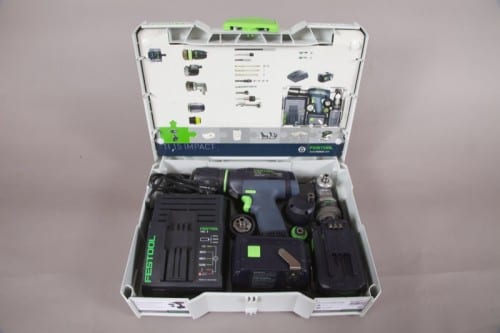
Festool TI 15 Impact Drill Driver Features
The +3 Kit for this evaluation has a street price of $800, but the tool can be purchased with just the Keyless Drill Chuck and the Centrotec Chuck for $525. The TI 15 Impact/Drill Driver is not only light in weight; it also has great balance and an ergonomic pistol grip. Combining an impact driver with a drill driver, the tool couples to an ensemble of chucks—making one tool do the job of many. Magically, the tool senses which chuck is attached, only allowing impact mode with direct attachment of a bit in the arbor or with the Centrotec Chuck directly attached. To my thinking, a drill driver has a clutch system to allow precise torque when driving screws. The TI 15 is only a true drill driver when the Depth Stop Chuck, which incorporates a clutch, is attached. The Depth Stop Chuck is not included in the +3 Kit but can be purchased separately for another $100.
The TI 15 has an innovative horizontally-sliding belt clip that snaps to one of three positions: left right or center. In the center position, it extends on both sides of the tool, albeit a small amount. With tool belts or heavy clothing this is problematic. Snapped left or right it hooked to my tool belt or the pocket of my Carhartt Jack with assurance. I found the belt clip especially handy when working on ladders. And, if a belt clip is not to your liking it is quickly removable without tools.
The Festool TI 15 Impact Drill Driver sports two 14.4 volt lithium-ion batteries and an intelligent rapid charger that will reinvigorate a dead battery as quickly as it deems is safe for the cells—between 35 and 70 minutes. The intelligent charger monitors individual cells in the battery and tapers the charging rate toward the end to minimize degradation. Festool standardized all of its batteries in 2005, so there is compatibility across all tools of like voltage. The charger will also refresh Festool’s earlier nickel metal hydride (NiMH) and Ni-Cd batteries, which, incidentally, will run the tool just fine. On the Li-ion batteries, however, you get an integrated battery level indicator that tells you the amount of juice left in the pack before you need to find a place to plug in the charger.
Battery charge level meter is a nice touch.
The Festool TI 15 Impact Drill Driver has magnetized grooves around the base of the pistol grip. You can store a gaggle of bits in these grooves; however, they can be knocked out fairly easily when working under counters and the like. I tend to only store the few bits I am working with for this reason. The Systainer lacks any true compartment for driver and drill bit storage, which I think could be a nice improvement. In the past, LED lights on portable tools have been a joke, but the light on the TI 15 is quite good. It comes on with the trigger and remains lit for about two seconds after release.
At a max speed of 2,600 RPM and with 3,600 hammer blows per minute, the Festool TI 15 Impact Drill Driver is about the fastest cordless drill I have ever had the pleasure to use. I sanded a bowl at my lathe to good effect, which is something heretofore only a plug-in model had enough speed to accomplish. And here we find a most unusual feature for a cordless drill—at the base of the pistol grip is a speed dial that decreases both the speed and impact rate to as low as 1,000 RPM and 2,400 blows per minute in 15 click steps.
Another tour de force of technology is Festool’s brushless motor, which is 30% more efficient than a brush type motor. This is because of much lower loss in power transmission to the armature. It also results in zero maintenance.
The impact mode produces 885 inch-pounds or just a skosh under 74 foot-pounds. There are lots of impact drivers putting out more torque, typically around 110 to 120 foot-pounds. That being said, I found the TI 15 to drive even common 1/4″ and 3/16″ lag screws with aplomb. Battery life was also very good during impact driving, and I seldom outran the second lithium-ion battery and the Intelligent Charger. It may be the rapid 2,400 to 3,600 blows per minute and the efficiency of the brushless motor that makes this tool seem as powerful as my aging 117 foot-pound Ridgid.
Festool gives very conservative drilling specs in their literature and on their website. For steel, it is just below 7/16” (10mm), and for wood, just a bit more than 9/16” (15mm). I chucked a 1-½” Forstner bit up and drilled some holes in red oak without too much complaint, but battery life diminished fast. When the tool is overloaded or stalled, it chirps. With the 1-½” Forstner, it definitely seemed like there was a canary or two helping me. The tool handled 1” brad point augers just fine and has more than enough power for average work, be it metal or wood.
The Many Personalities of the TI 15
This is the Festool TI 15 Impact Drill Driver with no chuck at all. ¼” bits and holders can be fitted directly to the driver. You get full impact mode with direct attachment, but bits will not lock in place and fall out when the tool is pointed downhill. Except in rare circumstances, say you are on a roof and the Centrotec Chuck is on the front seat of the truck, this is not a very useful mode.
Using the Centrotec Chuck with Festool ¼” bits. Mounting ¼” hex shank bits is fast and sure by sliding back the Centrotec Locking Ring and installing the bit. Fitting the supplied Magnetic Bit Holder allows use of third party bits and fast bit/drill swaps. The Centrotec Chuck, however, will only accept Festool bits.
Using the ½” Keyless Drill Chuck turns the Festool TI 15 Impact Drill Driver into an ordinary cordless drill. The keyless chuck is the best I have ever used on a drill motor, grabbing with absurdity down to less than 1/16”. It grips better than Swiss alpine skier Daniel Albrecht. Once you snug up the jaws on the shaft of the drill pulling back on the ridged barrel causes the chuck to go into what Festool calls Ratchet Mode. The spindle locks and the chuck audibly clicks as you tighten. The result is great holding on a drill bit with no slippage. This is much safer than holding the barrel and running the drill, which is necessary with competitors.
The following chucks require the TI-FX Adaptor. This allows them to be rotated anywhere within 360º in 16 different positions, as your work or application dictates.
The Eccentric Chuck allows getting right up to edges and in corners. This is a great chuck for cabinet builders and installers. It takes third party bits directly but will not accept the Centrotec Chuck. For drilling, you will need hex shank drill bits.
The Right Angle Chuck accepts third party ¼” hex bits directly or can be used with either the Centrotec or the Keyless Drill Chuck. This is useful anytime you need a right angle drill but most useful with ¼” hex bits for installing or adjusting drawer slides. In my experience, you need two hands for right angle drills, as one hand runs the trigger and the other puts pressure at the elbow. Being able to position the Right Angle Head anywhere within 360º makes the TI 15 much more versatile than a dedicated right angle drill.
While the Depth Stop Chuck is not supplied with the TI 15 +3 Impact/Drill Driver it is available separately for about $100. This chuck incorporates a clutch that allows for precise torque and exact depth setting of screws. It is perfect for drywall, deck and cabinet situations where precise depth every time is mandatory. In my opinion, it is only with the Depth Stop Chuck you can truly classify the TI 15 as a full Drill Driver.
We probably shouldn’t show you this, but…
Festool bits are proprietary. Like all other bits they are just under ¼” (about .247) across the flats to fit a ¼” chuck, but they are .010” smaller across the corners. The Centrotec Chuck matches this sizing, prohibiting the use of most box store bits. Woodcraft Supply, who is a major reseller of Festool, now offers third party bits to fit the Centrotec. There is a simpler solution, however. In a Festool heal-thy-self spirit, most third party bits may be chucked backwards in the Keyless Drill Chuck. That means you can have the hex part of the bit extend out from the nose of the chuck. Do this, then very lightly touch the bit to a bench grinder (preferably on a fine wheel) while running the drill at full speed in reverse direction to the grinding wheel. After grinding both above and below the locking groove, you’ll find that your bit will now seat home in the Centrotec. Incidentally, this is also a great trick for dressing the point of a center punch.
Conclusion
There is a lot to like about the Festool TI 15 +3 Impact / Drill Driver. It’s an impact driver, and a regular drill with a fabulous keyless chuck. It can morph to a right angle drill, with or without the keyless chuck. With the eccentric offset chuck it does corners. With the purchase of the Depth Stop Chuck it becomes even more powerful, setting screws to specific depth and torque. If a lot of small screws to specific depths is your calling, one of Festool’s superlative clutch type drill drivers, sans an impact feature, might better serve you. If drywall, deck, and lags are your mainstay, this is your tool.
That’s not to say that the Festool TI 15 Impact Drill Driver is perfect. A place in the Systainer to store excess drill and driver bits would be nice. A clutch feature in the motor of the TI 15 itself would be nirvana. Power tool websites (Festool included) abound with video of impact drivers sinking gargantuan lags into heavy timber. In practice, craftsmen seldom do this, as a hole drilled 70% the root diameter of the thread in less dense woods, and 90% in dense woods, gives much greater holding strength. Therefore, in the past, I have used the combination of the Festool TDK 12 Drill and Ridgid Impact Driver alluded to earlier. I first drill the hole and then use the impact driver to sink the screw. With the TI 15 Impact, changing between the keyless chuck and the Centrotec Chuck is quick enough that one tool could easily replace two.


